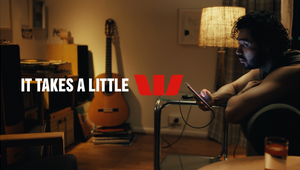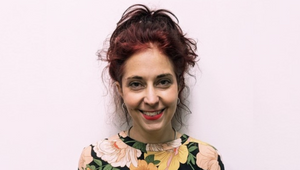
By Design: Fiona McLeod on Being Obsessed with Art Attack and Minimalism

Fiona McLeod is a design director at globally acclaimed creative agency BMF, where she helps develop brand identities and campaigns for some of the world’s most prominent brands. Fiona has worked for clients such as Tourism Tasmania, ALDI, Federal Government, Clear Skincare, Viking Cruises, Norwegian Cruise Liner, Nestle and Unilever.
LBB> Tell us about your current role and design specialism(s)?
Fiona> I am currently the design director at BMF and have been on the tools for over 15 years. I love minimalism, negative space, quirky letterforms and unexpected colour palettes. For the past four years, I’ve been working on the Tourism Tasmania account, helping launch the brand’s award- winning ‘Come Down for Air’ and ‘Off Season’ brand platforms. While working on the account, I’ve had the privilege of expanding Tourism Tasmania’s design identity across multiple channels and ideas, including ‘Off Cuts’ - a bespoke, eco-friendly winter clothing collection made solely from reused summer tourism merchandise.
LBB> What drew you to design in the first place and how has your design career evolved?
Fiona> When I was a kid, I was obsessed with Art Attack. I made every paper-mached-goggley-eyed-paper- crimped and kaleidoscopic creation you could think of. Then I’d gift these clag-glue crafts to my weary parents. I always liked getting crafty, so after school, I did the closest degree possible - a Bachelor of Design at Griffith Queensland College of Art.
After uni, I tested out pretty much every design discipline you could think of. I’ve worked as a kid’s textile designer, a publication designer, a finished artist, packaging designer for Marks & Spencer and a signage and wayfinding designer for large cruise ships. But then I eventually found my true calling in brand design.
LBB> What aspects of design do you get really nerdy about personally?
Fiona> I am a true font nerd. What gets me excited is sourcing beautifully crafted letterforms, the humble ascenders and descenders that help carry important words and messages. Typography can make or break an identity so I love searching high and low for perfect pairings on some of these great font foundries; Panagram, Panagram Foundry, Grilli, Typeverything, and Dinamo.
LBB> There are so many new design tools out - what tools do you like to use and why?
Fiona> When you’re feeling stuck or in a rut, getting back to basics and having some screen-free time can work wonders. It could be as simple as cooking or gardening or doing a creative workshop. Using your hands to make something can be incredibly rewarding and a welcome break. In the last few years, I’ve done Risograph workshops and print-making classes. Going back to these old techniques expands your mind, and there is something so satisfying about creating a tangible object.
LBB> What are the most persistent misconceptions about your particular design specialism that you see across the advertising and marketing landscape?
Fiona> A common misconception is that design is just the icing on the cake and comes after the creative idea is established. However, the reality is that design is always integral to a good idea. Design works hand-in-hand with creative and should never be an afterthought. What’s great about BMF is that we partner designers with creative teams early on-in-the process which produces a unique and nuanced creative outcome.
LBB> Accessible design is an increasingly prominent topic - from your experience what are the most challenging facets of accessible design? And what does best practice in accessible design in your particular design specialism look like?
Fiona> At BMF, we work on many government projects which go through various rounds of research groups. Working on the Census and Referendum campaigns was a big challenge, as the target audience is every Australian over the age of 18. Creating a design system that is both functional and aesthetic - and can be translated into hundreds of different languages and formats - is both challenging and rewarding. It’s important to partner with the experts early on and then test, learn and prototype designs to get the best outcome.
LBB> What design controversies or challenges do you find trickiest to navigate or do you find yourself thinking about most frequently?
Fiona> For me, design is feeling a bit iterative at the moment, everything is frenetic and more saturated than ever. If design were a child it’s as though we’ve given it too many sugary snacks and it’s on a sugar high. It feels like we’ve reached the ceiling of design trends. But this means that the opportunities lie in creating thoughtful, timeless and original designs that don’t rely heavily on trends and are true to the idea at heart.
LBB> How do you think about the ethics of design?
Fiona> One of the first projects I worked on was designing a flyer for a battered sav (also known as a dagwood dog - a saveloy sausage, coated in batter and deep fried). Now as harmless as this product might sound, that particular experience taught me that it's important to work on products you believe in (and dagwood dogs, I did not). At BMF we work on a lot of social change projects and design for good, including the prevention of domestic violence, child abuse, anti-vaping and smoking campaigns as well as a multitude of not-for-profit clients. This work is extremely rewarding and means I can sleep well at night knowing I’m helping to create change and not just shilling dagwoods.
LBB> What are some of your favourite examples of creative design solutions that inspire you?
Fiona> I'm a big fan of sustainable design and I love seeing design solutions that help fix long-term problems as well as anything related to product and packaging innovation. One example of this is Ryman Eco, a sustainable font developed by UK-based stationery retailer Ryman that uses 33% less ink than standard fonts. It's designed to be more ink-efficient, with narrower characters and larger spacing to reduce ink usage without sacrificing legibility. Also the new ‘dissolving bottle’ shampoo and conditioner products, that slowly dissolve over time, offer an alternative way to ditch toiletry containers and help reduce plastic pollution by evolving the packaging design.
LBB> Which design projects throughout your career have been the most satisfying to work on and why?
Fiona> Working on the Tourism Tasmania brand has been hugely rewarding. From the initial pitch, through to establishing the brand guidelines and crafting each campaign, it’s now a really functional and established brand that lives and breathes the campaign line. I truly think everyone needs to take a trip to Tassie, breathe in the fresh air and just slowwww down a little more.
LBB> What’s going on at the moment in design that’s getting you particularly excited?
Fiona> It’s great to see so many young women pursuing careers in design and advertising. At BMF 75% of our designers are women.
While it’s exciting to see so many young women pursuing careers in design and advertising, there’s still a shortage of women holding design leadership roles. Last time I checked it was sitting at around 11% globally… But it is getting better. Thankfully there’s a growing number of mentoring programs out there to help represent women, non-binary, and underrepresented or marginalised communities. Programs like Womentor, Rare with Google, Leadership Academy, and Assisterhood are hugely valuable.
LBB> Who are your design heroes and why?
Fiona> My heroes are all of the lovely and supportive designers I get to work with every day. At BMF, we’re a close-knit bunch of 12 designers, illustrators, creators, cat-lovers, craft-beer enthusiasts, over-thinkers and over-sharers.
When one of us is struggling we all huddle together and ‘Design by Committee,’ which could mean we are meticulously all kerning a word together or labouring over the perfect shade of acid green.
When you’re head down designing or ‘in the trenches,’ it’s easy to get decision overload, so nutting it out together always helps.
LBB> Thinking of people at the beginning of their career, what advice would you give them for navigating this constantly changing field?
Fiona> Learning when to stop. When to stop designing, stop concepting, stop searching, stop doubting, and stop clicking. Design jobs can go on and on, and the choices can be infinite. It's important to have confidence in your designs and the decisions you’ve made along the way. Of course crafting a project is important, but it's also important to protect your energy, your time, your boundaries and your wrists! My wrists are stuffed after 15 years of aggressive clicking and bad posture. So on that note, ergonomic chairs, mouse pads and good working habits are also a must!















